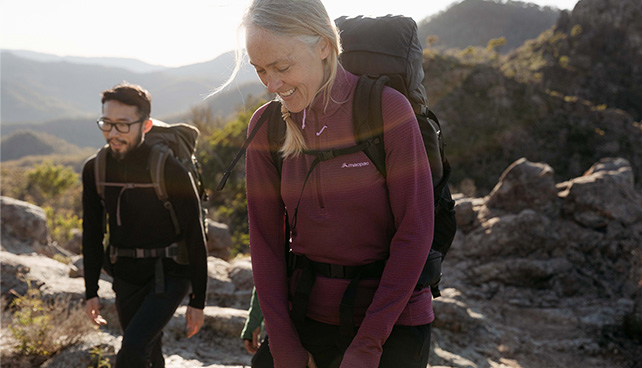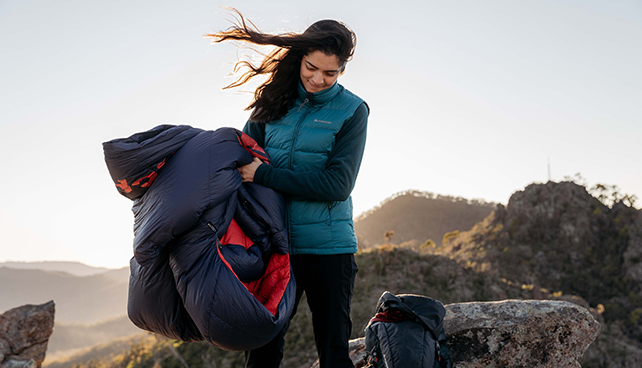In the right conditions, winter adventures can be truly rewarding. There’s an added element to planning around the weather, braving the cold, and avoiding the wet. But wearing the right gear can make all the difference when it comes to safety, comfort, and overall enjoyment.
Nothing’s worse than feeling underdressed. So, with that in mind, we’ve put together a guide to what you should be looking for in your layering system.
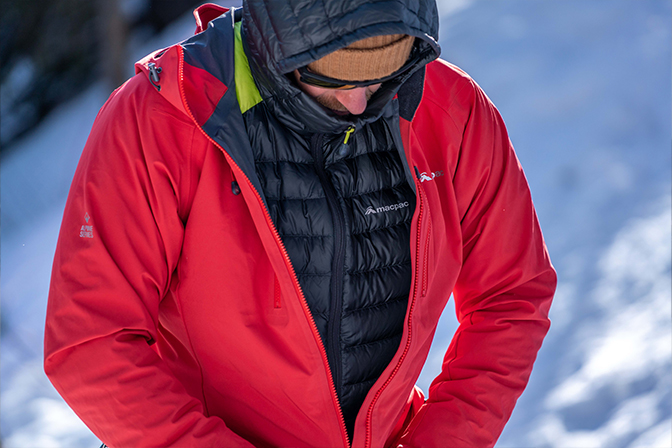
But first, what’s a layering system?
Heading out in any environment, especially a cold one, is less about having one super warm jacket and more about having the right setup of layers that you can pick from before you leave home and adjust on the fly should the conditions change.
When ‘four seasons in a day’ is a reality between as early as April and sometimes later than October — especially in New Zealand’s South Island — it’s essential to think of your layers in terms of a base, a mid and an outer. Within each layer, there are generally two options that we’ll explain here. The right one for you will become obvious when you think about what you’re heading outside for.
Ask yourself things like
Will I be getting sweaty?
What will I wear against my skin?
Will it keep me warm if it’s freezing outside, I get wet, and I’m an hour from the car?
Baselayers
Base layers sit directly on your skin, forming the foundation of your layering system. Their purpose is to manage moisture, provide warmth, and stop you from getting cold. The fastest way to catch a chill is to have a wet cotton garment on your skin, so you should avoid that. You’ve got two options when it comes to your base layer: natural merino thermals, or synthetic thermals.
Merino Thermals
Merino wool has evolved to be lighter, better at regulating temperature, antimicrobial, and naturally more comfortable on the skin. But 100% merino isn’t the best choice if you’re active and likely to sweat. That’s because wool naturally holds onto water. It gets heavy, damp, and uncomfortable when wet. One way around this is to look for products that use merino wool with synthetic fabrics.
When to wear: Merino is great for stationary or low-intensity activities, like watching the rugby from the sidelines on a crisp winter morning or heading off on a short walk on a cool evening. It’s popular among hikers who don’t want to stink out the hut — or their pack — with the smell of the day’s walk, either. Merino thermals come in different weights. The higher the weight the warmer the thermal. A 150 is a lightweight layer for natural warmth and easy layering and a 220 is a midweight layer better for keeping warm during colder temperatures.
Pros:
- Soft on the skin
- Anti-itch
- Naturally odour resistant (wear it for days before washing!)
- Naturally temperature regulating
- Breathable but slower to dry
Cons:
- Less durable than synthetic thermals
- Become heavy when wet
- More expensive than polyester options
- Slower to dry
Our pick: Men’s and women’s merino range.
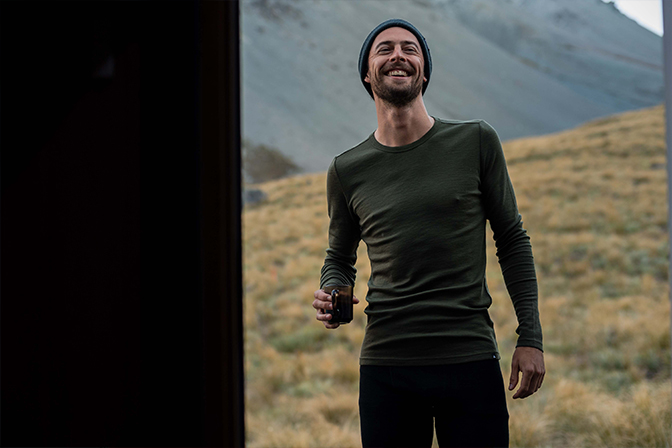
Synthetic Thermals
Most synthetic base layers are made from polyester or a polyester blend. This material is known for its durability, technical performance, versatility and most importantly its moisture management. Because of this, synthetic base layers are more suitable than merino when it comes to sweaty activities.
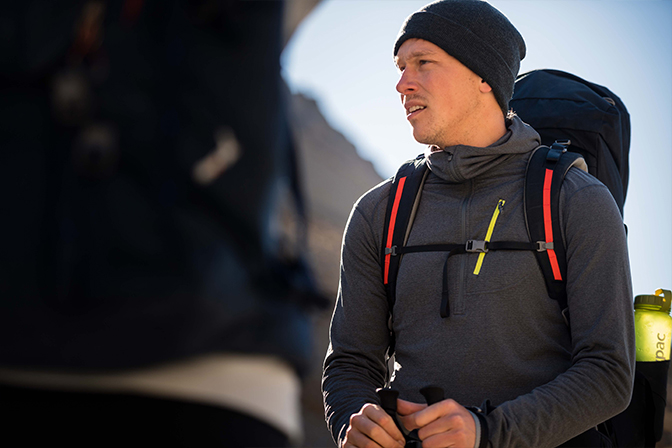
When to wear: Synthetic base layers are great for medium to high-intensity activity. Our highest-performing synthetic thermals are made using Polartec® Power Grid™, providing warmth and breathability without adding bulk.
Our pick: Men’s and women’s prothermals.
Pros:
- Lightweight and warm
- Durable and easy to care for
- Moisture wicking
- Fast drying
- Breathable
- Compressible
Cons:
- Need regular washing - will smell after wearing in sweaty conditions
- Doesn’t have the same natural temperature regulating ability as merino because it doesn’t hold any moisture
Mid Layers
Selecting the appropriate mid-layer can be tricky since it's what you wear over your thermals. Mid layers are highly versatile and can also be worn as an outer layer (more on those later) depending on the conditions. But in winter, when you’re almost always going to team your mid layer with a jacket, it’s all about insulation. You want to trap warm air close to your body and prevent cold air from getting in.
Merino Mid Layers
Merino mid layers team up well with merino base layers. They’re warm and comfortable if you’re not generating much body heat through movement. They’re also a good idea on a tramping or camping trip — not for use during intense periods of activity, but as a cosy option in the evenings.
When to wear: Merino mid layers are perfect for stationary or slow-paced activities, or as a warm option once your body temperature has cooled down.
Pros:
- Soft on the skin
- Anti-itch
- Naturally odour resistant (wear it for days before washing!
- Naturally temperature regulating
- Breathable but slower to dry
Cons:
- Less durable than synthetic mid-layers
- Holds moisture - becomes heavy when wet
- Slow drying
Fleece Mid Layers
Fleece is fast drying, continues to perform when wet, and provides great warmth. A high-quality, synthetic fleece will also play its part when it comes to wicking moisture. The process starts at your skin and ends with the expulsion of that moisture through your outer layer.
When to wear: Fleece is great for higher intensity winter activities such as tramping, trail running and ski touring. It’s also a versatile option for everyday life.
Our pick: men’s and women’s fleece ranges.
Pros:
- Fast-drying
- Continued performance when damp
- Exceptionally warm
- Highly versatile - works well for both high and low-intensity activities
- Hard-wearing - great in rugged conditions
Cons:
- Less breathable than wool - could develop an odour after extended wear
Down Mid Layers
Down is nature’s most efficient insulator — it’s unmatched in terms of its warmth-to-weight ratio. It’s also exceptionally lightweight and compact, making down jackets and vests easily stowable in your pack when you don’t need them. Down mid-layers are best for cool, dry conditions where you’re not sweating too much or prone to get wet, as down loses its ability to insulate when it gets wet or damp.
When to wear: When you’re hiking or walking in crisp conditions, a lightweight down jacket will easily fit under an outer shell. Down is not suitable for high intensity activities like trail running or tramping.
Our pick: Uber Light Down Jackets (men’s and women’s).
Pros:
- Exceptionally warm and efficient at insulating
- Lightweight
- Highly compressible making them convenient for packing away
Cons:
- Loses its ability to insulate when it gets wet


Synthetic Mid Layers
Synthetic insulation’s key benefit is that it still performs when wet or damp. It’s also low maintenance and easy to care for — you can wash it like any other garment. However, while it does offer great warmth and versatility, synthetic insulation doesn’t compress quite as well as down. It isn’t the best option if space is at a premium.
When to wear: Garments with synthetic insulation make great mid layers for medium to high intensity activities — particularly hiking or tramping trips where you are wearing a pack, might sweat, or if there’s a chance it may rain.
Our pick: Pulsar PrimaLoft® Hooded Jackets mens and Pulsar PrimaLoft® Hooded Jackets womens.
Pros:
- Continues to insulate when damp
- Not generally as expensive as down
- Low maintenance and easy to care for - wash just like any other sweater
Cons:
- Lower warmth-to-weight ratio - heavier to get the same warmth as down
- Not as lofty and soft as down
- Not as compressible as down
Outer Layers
As the name suggests, outer layers go on the outside. They protect you from the wind and rain — both significant factors when it comes to losing body heat — so water resistance and breathability are essential considerations.
Hardshell Outer Layers
Generally waterproof and wind-resistant, hardshells are an absolute must if you’re heading into wet conditions, as they’re the only thing keeping the rain (and snow) out.
When to wear: You don’t always need a hardshell, but you should always have one in your pack if there’s a chance it could rain. While waterproofness (measured by a fabric’s hydrostatic head, or HH rating) is the key consideration in a hardshell, breathability (measured in g/m2/24hrs) also needs to be considered if you plan on breaking a sweat.
Our pick: Traverse Pertex® Rain Jackets mens and Traverse Pertex® Rain Jackets womens.
Pros:
- Weather protection - they’ll keep out the wind and rain
- Lightweight - won’t slow you down with excess weight
- Packable - easily stow away into the bottom of your pack, taking up next to no room
Cons:
- Generally, less breathable than softshells
- Offer no additional insulation - simply keep the weather out
- Can be noisy when moving - especially with the hood up
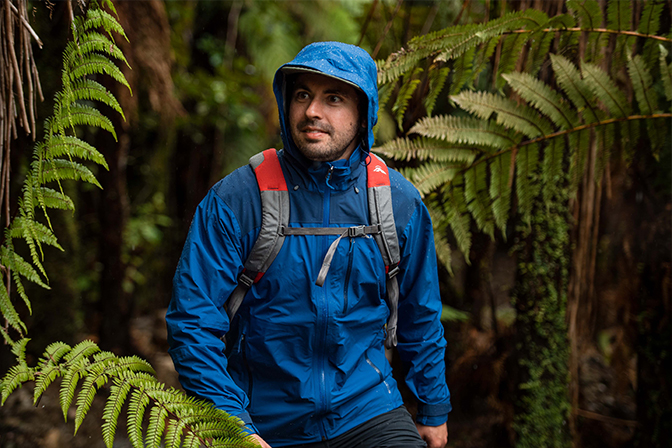
Softshell Outer Layers
There’s a huge variety of softshell options available, but the key function of a softshell is wind resistance. A softshell is constructed from less rigid materials, so your range of movement and abrasion resistance will be greater in a softshell than in a hardshell. Softshells will protect from the wind and light rain, and some have a soft fleece inner for extra warmth in winter.
When to wear: Apart from in situations where you’re likely to experience extended exposure to damp conditions or run into heavy rain: there’s a softshell for most outdoor activities. It all comes down to how much you’re likely to move, the type of activity you’re doing and how much protection you think you’ll need from the elements.
Pros:
- More breathable than hardshell rainwear
- They often have thermal properties with fleece inside for extra warmth
- Some are a lot less rigid and easier to move around in
- More breathable and comfortable than hardshells
Cons:
- Not fully waterproof. Suitable for light rain, but won’t protect you from a heavy and sustained shower
- Softshell jackets with membranes can feel a little heavier than some hardshells. If this happens, the trade-off may end up being between water resistance and weight
Insulated Outer Layers
Many people use an insulated jacket as their main outer layer — particularly for low intensity activities when they won’t be moving much at all, or in extreme cold where you are unlikely to sweat. These layers are primarily for providing warmth, but they will protect from very light rain and ice if the garment has a durable water repellent (DWR) coating.
When to wear: Insulated jackets work best when you’re not exerting yourself. They’re generally not suitable for high-intensity activities, however, a synthetic insulated outer can be necessary if you’re intermittently exerting yourself e.g. if you’re belaying for another climber.
Our pick: Icefall HyperDRY™ Hooded Jacket mens and Icefall HyperDRY™ Hooded Jacket womens.

